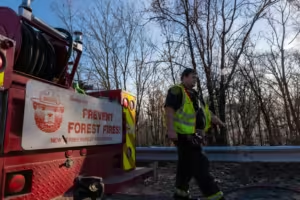Why have East Coast wildfires been breaking out this fall?

Officials reported Monday night that the Jennings Creek wildfire, which was consuming 3,500 acres and was 20% contained, was being fought by firefighters in New Jersey along the New Jersey-New York border. Over the weekend, 18-year-old Dariel Vasquez, a state parks employee in New York, was fighting fires in Orange County’s Sterling Forest when he was struck by a fallen tree.
Authorities in several Northeastern states fought wildfires Monday as conditions remained favorable for fires to start and spread swiftly, even though some regions had their first rain in more than a month. What we know about the flames, their origin, and whether more rain is expected is as follows:
What causes the Northeast’s wildfires?
Like the great majority of the nation, the Northeast is dealing with unusually dry circumstances, and severe and extreme drought is plaguing numerous states. Every fall, there are wildfires in the Northeast, and most of them are caused by human activity, including campfires, burning objects, and cigarette smoke. This year, however, a record-breaking dry period in the Northeast is causing a substantial increase in wildfires and their exponential expansion, which has state officials and meteorologists particularly worried.
Which Areas have been warned or alerted about the risk of wildfire?
Over the past week, alerts have been issued for areas from New England to Washington, D.C., regarding increased wildfire threats. By Sunday evening, the majority of those alerts had ended, but authorities nevertheless advised citizens to remain vigilant and to use caution while near possible sources of ignition, such as matches, cigarettes, or heavy machinery.
The New York metropolitan area, Connecticut, Rhode Island, and Massachusetts, for instance, were under red flag warnings on Saturday due to persistently dry conditions, strong winds, and relatively low humidity, according to the National Weather Service.
According to analysts, a deadly fire along the New York-New Jersey border could spread.

The 3500-acre Jennings Creek wildfire in West Milford, New Jersey, is 20% contained, according to the New Jersey Forest Fire Service. The fire is approximately 60 miles southeast of Manhattan and is consuming Orange County, New York, and Passaic County, New Jersey.
After burning across thousands of acres and killing an 18-year-old volunteer firefighter, a drought-fueled wildfire along the New Jersey-New York border is expected to expand more widely on Tuesday, according to forecasters. The fire was reported on Saturday, and that same evening, it expanded to Orange County.
A higher chance of spreading Tuesday: the National Weather Service
Given the strong winds and low humidity on Tuesday, National Weather Service forecasters are cautioning that there is a significant chance the fire will continue to spread.
New York forecasters cautioned in a Special Weather Statement Monday afternoon that humidity levels between 30 and 40% and wind gusts of up to 35 mph “will support the spread of any fires that ignite.”
What led to the fire?
The New Jersey Forest Incident Service is investigating the cause of the incident.
Does the Northeast frequently experience wildfires?
Although they are most prevalent in the spring, wildfires burn hundreds of acres of land in Northeastern states every year.
The New Jersey Forest Fire Service reports that every year 1,500 wildfires in the state destroy or damage 7,000 acres of woodlands. According to state officials, although spring is the peak season, leaves in the fall provide more fuel and cause more fires, particularly in extremely dry areas.
In Massachusetts, roughly 15 wildland fires are reported every October. The month’s total increased by over 1,200% this year to 200.
In which cities and states has there been no discernible precipitation?
Some storms brought the first rain in months to sections of the Mid-Atlantic on Sunday night and into the night. New York City received 0.17 inches of rain, the first rainfall in the metropolitan region since late September. The dry spell has broken records in several cities in New Jersey. The previous record was 36 days in the fall of 1924; Trenton had gone 41 days as of Friday without any discernible rain. Newark has surpassed the previous record of 26 days set in the spring of 1949 by going 40 days without any discernible rainfall.
Philadelphia also broke the record of 29 days without rain, set in 1874, by going at least 40 days without rain.
